Prelims Reviewer - Data Structures and Algorithm
1/105
There's no tags or description
Looks like no tags are added yet.
Name | Mastery | Learn | Test | Matching | Spaced |
|---|
No study sessions yet.
106 Terms
Data Structure
Particular way of storing and organizing data in a computer so that it can be used efficiently
Data Structure
Based on the ability of a computer to fetch (retrieve) and store data at any place in its memory, specified by an address
Address
Bit string that can be itself stored in memory and manipulated by the program
Data Structure
Requires writing a set of procedures that create and manipulate instances of that structure
Data Structure Types
Primitive (ex. int, char)
Non-Primitive (ex. Array, Vector)
Data Structure Classification (Element)
Homogenous (Singular type, ex Array)
Heterogenous (Multiple type, ex Structure)
Data Structure Classification (Size)
Static (Immutable, ex. matrix)
Dynamic (Mutable, ex. list)
Data Structure Classification (Relationship)
Linear (ex. array)
Non-Linear (ex. tree)
Main Memory (RAM)
Where instructions (programs and data are stored
Volatile
Cache Memory
Used to store frequently used instructions and data that either is, will be, or has been used by the CPU
Fastest access speed
Register
Segment of CPU Cache
Small amount of memory that is used to temporarily store instructions and data
Persistent Storage
Used to store instructions and data in external devices such as a hard disk
Non-volatile, commonly used by the operating system as virtual memory
Slowest access speed
Reserving Memory
Data is stored in memory and manipulated by various data structure techniques
Organized into groups of eight bits called a byte, enabling 256 combinations of zeroes and ones that can store numbers from 0 through 255
Before storing, tell the computer how much space to reserve for data using an abstract data type
Abstract Data Type
Keyword of a programming language that specifies the amount of memory needed to store data and the kind of data that will be stored in that memory location
Abstract Data Type Examples
Java ADT
C & C++ ADT
Data Type Groups
Integers
byte - 8
short - 16
int - 32
long - 64
Characters
char - 16 (Unicode)
Floating-Point
float - 32
double - 64
Boolean
bool - 1
Algorithm
Step-by-step procedure, which defines a set of instructions to be executed in a certain order to get the desired output
Algorithm Categories
Search
Sort
Insert
Update
Delete
Algorithm Characteristics
Unambiguous
Input
Output
Finiteness
Feasibility
Independent
Algorithm Analysis Types
Priori
Posterior
Priori Analysis
Efficiency of an algorithm is measured by assuming that all other factors are constant and have no effect on the implementation
Posterior Analysis
Analysis where actual statistics like running time and space required, are collected
Algorithm Complexity Factors
Time factor
Space factor
Algorithm Complexity f(n)
Gives the running time and/or the storage space required by the algorithm in terms of n as the size of input data
Space Complexity
Represents the amount of memory space required by the algorithm in its life cycle
Space Complexity Parts
Fixed part
Variable part
Time Complexity T(n)
Amount of time required by the algorithm to run to completion
Measured as the number of steps, provided each step consumes constant time
Asymptotic Analysis
Defines the mathematical foundation/framing of its run-time performance
Asymptotic Analysis
Used to conclude the best case, average case, and worst-case scenario of an algorithm
Asymptotic Analysis
Computes the running time of any operation in mathematical units of computation
O Notation
Worst-case time complexity
Ω Notation
Best-case time complexity
θ Notation
Average-case time complexity
Common Asymptotic Notation
Constant - O(1)
Logarithmic - O(log n)
Linear - O(n)
n log n - O(n log n)
Quadratic - O(n2)
Cubic - O(n3)
Polynomial - nO(1)
Exponential - 2O(n)
Rate of Growth
How fast a function grows with input size
Data Abstraction
Simplify code by displaying only essential details to the user
Interface
Special block containing method signatures
Defines method signatures without body
Defines standard and public specification of class behavior
Allows classes, regardless of hierarchy, to implement common behaviors
May exhibit polymorphism
Abstract Class
Declared using “abstract”
No implementation
None, abstract, and/or concrete methods
Abstract Method
Redefined in subclass
Always overridden
Container class must be declared with “abstract”
No object
Interface vs Abstract Class
Interface
Methods have no body
Define constants
No direct inheritance
Tree
Which of the following is NOT a linear data structure?
Hiding implementation details and showing essential features
Abstraction in data structures means:
ArrayIndexOutOfBoundsException
What happens if you access an index of an array that is out of bounds in Java?
Abstract classes can have implemented methods, but interfaces cannot
In Java, which of the following statements about abstract classes and interfaces is true?
It reduces complexity by hiding implementation details
How does abstraction improve software development processes?
30

It initializes an array with 5 elements
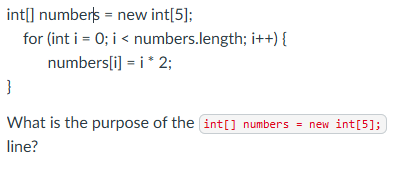
[0, 2, 4, 6, 8]
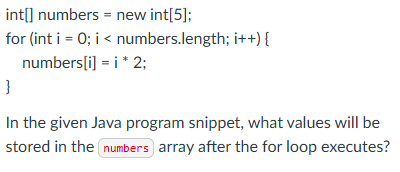
It limits the number of iterations based on the array length
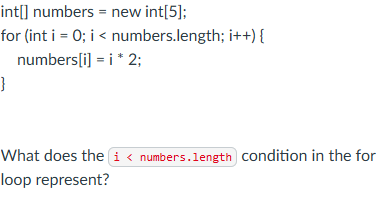
The loop would access an invalid index
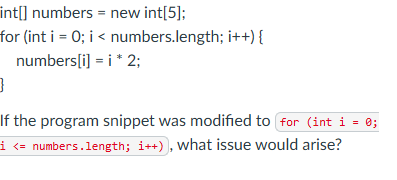
System.out.print(numbers[i] + " ");
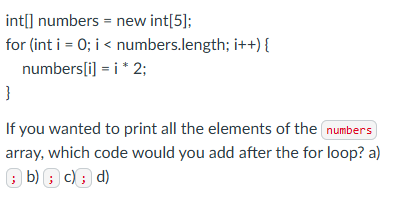
Type
Integer is a primitive, while Array is a non-primitive. Under which classification of data structures does this fall?
1 2 3 4 5

True
An algorithm is a step-by-step procedure, which defines a set of instructions to be executed in a certain order to get the desired output.
False
To implement a data structure, it requires writing set of array that create and manipulate instances of that structure.
Interfaces
In Java, which of the following can be used to implement multiple inheritance?
abstract void methodName();
Which of the following is the correct way to declare an abstract method in Java?
HU/M*ILI^-TY^+
CONVERT FROM INFIX TO POSTFIX:
H / U * M - (I ^ L I) + T ^ Y
CO+M-P*UTE^/R-
CONVERT FROM INFIX TO POSTFIX:
(C + O - M) * P / (U ^ T E) - R
((A+B)+(((C+(D*E))/(F-G))+H))
CONVERT FROM POSTFIX TO INFIX:
A B + C D E * + F G - / H ++
ArrayList
Part of collection framework and is present in java.util package
Provides a dynamic way of manipulating data
Slower than standard arrays but can be helpful in programs where lots of manipulation in the array is needed
ArrayList Characteristics
Inherits AbstractList class and implements List interface
Initialized by size, however, the size can increase if collection grows or shrunk if objects are removed from the collection
Allows random list access
Use a wrapper class if an ArrayList can not use primitive types, like int, char, etc.
Similar to a vector in C++
ArrayList Constructors
ArrayList() - empty array list
ArrayList(Collection c) - initialized with the elements from collection c
ArrayList(int capacity) - initial capacity being specified
ArrayList Methods
add(int index, Object element)
add(Object o)
addAll(Collection C)
addAll(int index, Collection C)
clear()
clone()
contains? (Object o)
ensureCapacity?(int minCapacity)
forEach?(Consumer<? super E> action)
get?(int index)
indexOf(Object O)
isEmpty?()
lastIndexOf(Object O)
listIterator?()
listIterator?(int index)
remove?(int index)
remove?(Object o)
removeAll?(Collection c)
removeIf?(Predicate filter)
removeRange?(int fromIndex, int toIndex)
retainAll?(Collection<?> c)
set?(int index, E element)
size?()
spliterator?()
subList?(int fromIndex, int toIndex)
toArray()
toArray(Object[] O)
trimToSize()
add(int index, Object element)
Insert a specific element at a specific position index in a list
add(Object o)
Append a specific element to the end of a list
addAll(Collection C)
Append all the elements from a specific collection to the end of the mentioned list
addAll(int index, Collection C)
Insert all of the elements starting at the specified position from a specific collection into the mentioned list
clear()
Used to remove all the elements from any list
clone()
Used to return a shallow copy of an ArrayList.
contains? (Object o)
Returns true if this list contains the specified element.
ensureCapacity?(int minCapacity)
Increases the capacity of this ArrayList instance, if necessary, to ensure that it can hold at least the number of elements specified by the minimum capacity argument
forEach?(Consumer<? super E> action)
Performs the given action for each element of the Iterable until all elements have been processed or the action throws an exception
get?(int index)
Returns the element at the specified position in this list
indexOf(Object O)
The index the first occurrence of a specific element is either returned or -1 in case the element is not in the list
isEmpty?()
Returns true if this list contains no elements
lastIndexOf(Object O)
The index of the last occurrence of a specific element is either returned or -1 in case the element is not in the list
listIterator?()
Returns a list iterator over the elements in this list (in proper sequence)
listIterator?(int index)
Returns a list iterator over the elements in this list (in proper sequence), starting at the specified position in the list
remove?(int index)
Removes the element at the specified position in this list
remove?(Object o)
Removes the first occurrence of the specified element from this list, if it is present
removeAll?(Collection c)
Removes from this list all of its elements that are contained in the specified collection
removeIf?(Predicate filter)
Removes all of the elements of this collection that satisfy the given predicate
removeRange?(int fromIndex, int toIndex)
Removes from this list all of the elements whose index is between fromIndex, inclusive, and toIndex, exclusive
retainAll?(Collection<?> c)
Retains only the elements in this list that are contained in the specified collection
set?(int index, E element)
Replaces the element at the specified position in this list with the specified element
size?()
Returns the number of elements in this list
spliterator?()
Creates a late-binding and fail-fast Spliterator over the elements in this list
subList?(int fromIndex, int toIndex)
Returns a view of the portion of this list between the specified fromIndex, inclusive, and toIndex, exclusive
toArray()
This method is used to return an array containing all of the elements in the list in the correct order
toArray(Object[] O)
It is also used to return an array containing all of the elements in this list in the correct order same as the previous method
trimToSize()
This method is used to trim the capacity of the instance of the ArrayList to the list’s current size
Stack
Way to group things together by placing one thing on top of another and then removing things one at a time from the top
Last-In, First-Out
push()
Adds to the top of the list
pop()
Removes an item from the top of the list and returns this value to the caller
Stack
Restricted data structure because only a small number of operations are performed on it
Stack
Linear data structure that follows a particular order in which the operations are performed
Stack
Extends Vector which implements the List interface
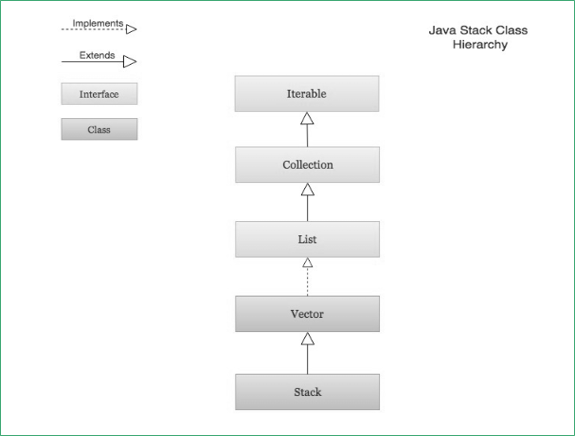
Stack Hierarchy